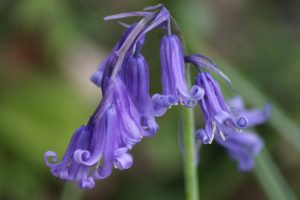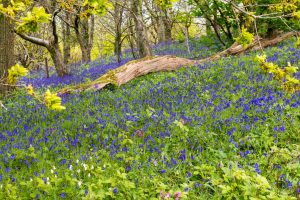By Andy Winfield

In April everything becomes green again. Leaves are bringing colour to bare branches and a skip to our step. Spring bulbs are almost at the end of their moment; leaves on trees mean darkness under canopies, but there’s still time, just before the leafy curtains are fully drawn, for one of the most joyful sights. Bluebells.
The native bluebell that carpets the woodland floor and causes many an intake of breath, is called Hyancinthoides non-scripta and has been furnishing the late spring forest floor for thousands of years. This is a plant that is very British Isles, although not to be confused with the Spanish bluebell, H.hispanica, which has larger, upright flower stems that are paler blue and don’t nod to the ground. Despite being found in other parts of Europe, 50% of all H.non-scripta reside here. It’s one of those plants that is enchanting en masse, and even more captivating when you take time to examine it closely; the tepals delicately curled back on themselves like rolling waves while the blue seems deeper or paler depending on which angle you look at it, and all hanging towards the ground apologetically.
 Happiest in deciduous woodland the roots of the bluebell are known as ‘contractile roots’; they ingeniously pull the bulb further into the soil, safely away from digging snufflers. This dragging downwards of the plant begins with germination which tends to happen before winter; the root appears first, and the seed is hauled down into the leaf litter where it is protected from frost. As time goes by the bulb can end up 25cm below ground where it encounters arbuscular mycorrhiza (friendly fungi) which infiltrate its root cells. A trade-off that has been thousands of years at the negotiating table takes place between the two; bluebells get a larger rooting zone and phosphorous, and the fungi gets carbohydrates. As the bluebell gets older, it relies more on the fungi to give it the nutrients it needs as it gets deeper in the ground. Meanwhile, above the ground, the bluebell flower is feeding a vast array of butterflies, bees, and hoverflies; this is a vital plant for pollinators.
Happiest in deciduous woodland the roots of the bluebell are known as ‘contractile roots’; they ingeniously pull the bulb further into the soil, safely away from digging snufflers. This dragging downwards of the plant begins with germination which tends to happen before winter; the root appears first, and the seed is hauled down into the leaf litter where it is protected from frost. As time goes by the bulb can end up 25cm below ground where it encounters arbuscular mycorrhiza (friendly fungi) which infiltrate its root cells. A trade-off that has been thousands of years at the negotiating table takes place between the two; bluebells get a larger rooting zone and phosphorous, and the fungi gets carbohydrates. As the bluebell gets older, it relies more on the fungi to give it the nutrients it needs as it gets deeper in the ground. Meanwhile, above the ground, the bluebell flower is feeding a vast array of butterflies, bees, and hoverflies; this is a vital plant for pollinators.
 Humans have lived alongside bluebells for a long time, and through this relationship myths and folklore emerge enhancing our connection with plants. Bluebells have long been thought to be heavily linked with fairy magic, and not good fairies either; next time you’re in bluebell woods, be careful of their mischievous enchantments. If you hear a bluebell tinkle, then a bad fairy is on its way to reap misfortune on you. And never pick a bluebell; you’ll be summoning a fairy to lead you away to a place you’ll never return from, wandering around lost forever.
Humans have lived alongside bluebells for a long time, and through this relationship myths and folklore emerge enhancing our connection with plants. Bluebells have long been thought to be heavily linked with fairy magic, and not good fairies either; next time you’re in bluebell woods, be careful of their mischievous enchantments. If you hear a bluebell tinkle, then a bad fairy is on its way to reap misfortune on you. And never pick a bluebell; you’ll be summoning a fairy to lead you away to a place you’ll never return from, wandering around lost forever.
Bluebells have had their practical uses for our ancestors as well, hopefully not inciting the wrath of fairies. The sap from the stem is very sticky and was used as a glue in bookbinding as well as for feathers to be stuck onto arrows; Robin Hood must have picked his fair share in Sherwood Forest. The bulbs had their uses too; they’re full of starch which was very useful to people of the Elizabethan age; the ruff collars preferred by the Queen and her people were stiffened with bluebell bulb starch.
So as you see, there is more to this seasonal signpost than meets the eye… even though what meets the eye is one of the horticultural highlights of the year.


A short and interesting article. Many thanks, I now understand how the bluebell evades my constant removal of them in my small garden. Some of them are deeper than I go down. I have removed bucks full, they are the Spanish Bluebell. It would be interesting to know how long they have been around in the UK and along country verges, and whether the native bluebell is being edged out by these.
Thank you for your comment. The Spanish bluebell has been in the UK for around 300 years; yet it wasn’t recorded in the wild until the early 1900s. There is a hybrid between the two which is said to be more common than the Spanish version.